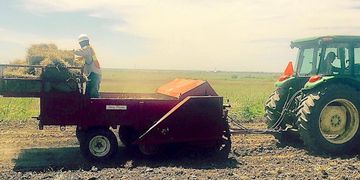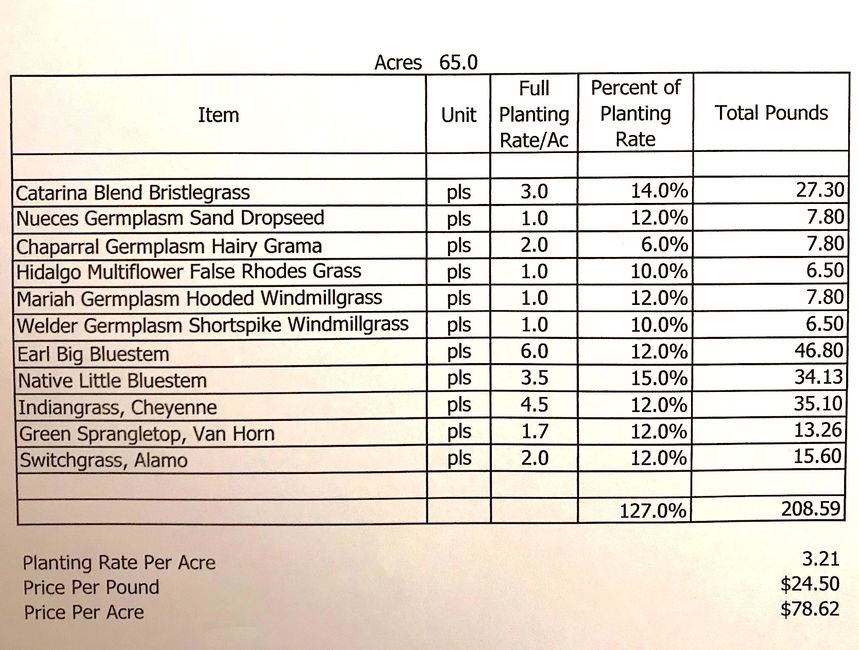HOW DO I CHOOSE BETWEEN GRASSES?
JIGGS BERMUDA - CATTLE & HAY
GOOD ALL AROUND CHOICE OF GRASSES - EASY TO GROW & ESTABLISH..
- LARGER LEAF/ THINNER STEM
- EASILY ESTABLISHED.
- FAST GROWING.
- DROUGHT TOLERATE, WITH
LONGER ROOT SYSTEM.
TIFTON 85- CATTLE & HAY
HIGH YIELDING HYBRID BERMUDA BERMUDA GRASS.
-HIGH RATE OF GAIN FOR CATTLE.
- GOOD IN SANDY SOILS
- LONGER TIME TO GET ESTABLISHED.
- LARGEST LEAF & LARGER STEM.
-ATTENTION TO BALING IMPORTANT AS IT CAN GET STEMMY IF NOT CUT O TIME.
NATIVE GRASSES- WILDLIFE HABITAT & SUSTAINABLITY
ALLOWS FOR A DIVERSITY OF LAND USAGE.
--USE TO RE-ESTABLISH NATIVE GRASSES FOR WILDLIFE PURPOSES.
-ALLOWS LANDOWNER TO CHOOSE WHAT HE WANTS TO GROW & ATTRACT IN WILDLIFE.
--ALLOWS FOR A BALANCE OF LAND USAGE, FOR BOTH WILDLIFE & IMPROVED PASTURES FOR CATTLE & HAY.
GRASSES - ENSURING THE CUSTOMER OF THE BEST OUTCOME
TYPES OF GRASSES- IMPROVED BERMUDA & NATIVE GRASSES
TYPES OF GRASSES :
Stephen D.Naiser Custom Grass Planting specializes in both improved pasture, (ordinarily used for hay or for cattle production), but, also in a variety of Seed and Native Grasses, often planted for wildlife habitat and enhancement, and sustainability.
LISTED BELOW ARE THE FAVORITES; but, we can also plant others, depending upon personal preference, geographic area, or job requirements.
1) JIGGS BERMUDA - Jiggs Bermuda is a grass that originated in South Texas and has been made popular by Texas A&M University. Jiggs is the best all-around Bermuda grass; it is also the grass that SDN plants most frequently. It has a superior root system that adapts to all soil types and conditions.
2) TIFTON 85 BERMUDA- Tifton 85 is another excellent grass. The larger stem gives an advantage over Jiggs in some ways; although with the larger stem, it must be handled differently, as far as usage and cutting time. Also, it’s root system is not compatible with all types of soils or conditions.
3) SEED GRASSES AND NATIVE GRASSES: Due to the large variety and types of native grass, we do not list everything we seed. Purpose, location of land, type of soil, climate and future maintenance all play a vital role in determining the exact variety of grass to be planted.
Stephen will consult with landowners on types of grasses, considering all facets of landowners’ needs, as well as whatever s required by...????? Other brands available on request.
PLANTING OF IMPROVED BERMUDA GRASSES

PLANTING OF BERMUDA GRASSES:
There are various methods one can use for planting or seeding, including broadcasting, or precision drilling, the method chosen depending upon a number of variables. Precision planting is the method Stephen Naiser Custom Grass utilizes for improved Bermuda grasses. This involves a machine that incorporates four steps, resulting in far superior results over traditional broadcasting.
The Precision Planting Method:
1) Opens a furrow.
2) Drops in the tops of grass.
3) Closes the furrow.
4) Compacts the soil over the grass.
Benefits of This Method Are:
1) Approximately 90% of the tops grow.
2) Using this method, the grass planted will often remain viable for up to 3 months with no rain.
3) The cost of planting is about half the cost of broadcasting, with no loss of spriggs left on top of ground. (This cost depends upon the number of acres, location, ground condition, and type of grass planted.)
NOTE: STEPHEN WILL CONSILT WITH LANDOWNERS ON TYPES IF GRASSES, CONSIDERING ALL FACETS OF A LANDOWNER'S NEEDS, AS WELL AS WHAT MAY BE REQUIRED OF DIFFERENT NRCS, OR LAND RECLAMATION PROGRAMS.
(Other types grasses available on request.)
PLANTING OF SEED & NATIVE GRASSES

PLANTING OF SEED AND NATIVE GRASSES:
Whatever type of seeding you need, there are many reasons for planting seed grasses. If it is for erosion control, hunting, restoring native pastures for wildlife, or re-claiming land after exploration or damages, clients can either direct us as to their choices of seed grasses, or we can help determine the best choices for their needs.
Again, much depends upon type of soil you have, time of year, and a number of variables. Stephen is an avid hunter and rancher, this combined with years of personal experience, as well as work with extension agents, wildlife institutions, and research facilities, have given Stephen a unique perspective on this aspect of grass planting.
Again, precision planting is the chosen method here; although different equipment is used to implement this type of planting. Using a state of the art, no till seeder, seed is precision drilled into the ground.
Benefits of This Seeding Method Are:
1) It is especially calibrated to allow the exact amount to be planted; therefore, ensuring no waste.
2) Seed is placed consistently at the chosen depth.
3) Seed tubes allow for two different types of seed to be planted at the same time, both native grass seed and small seed.

A SAMPLE OF NATIVE GRASSES WE MIGHT PLANT
SEE EXAMPLE ABOVE OF GRASSES WE MIGHT PLANT, WITH RATES, PERCENTAGES, ETC.
We are asked al the time what kinds of NATIVE GRASS SEED WE PLANT, HOW MUCH, PLANTING RATE, POUNDS, and so much more. The selection of grasses is limitless, and depends upon what you are hoping to attain in your pasture, or food plot establishment.
Regardless of your choices or needs, we can meet those, and do the job right. With our PRECISION PLANTING MACHINE, which we can calibrate to allows us to put out a variety of grasses simultaneously, we can plant the proper amount, and percentage of seed desired, with the added efficiency of doing it all with one machine, in the shortest length of time possible.
